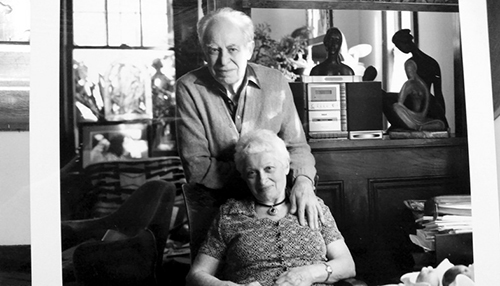
“I always have to find a new way and reinvent myself,” says 85-year-old Aggie Adler. She wants to help people and says, “God gave me the possibility to do great things, and that is what I want to do with the few years I have left.
Recently, Adler suffered the terrible loss of her husband, David, after 50-plus years of marriage, but she continues to feel a need to accomplish. Adler has adapted and adjusted to new situations her entire life, beginning in Hungary in 1944. Her father was detained in a work camp when the rest of the Jews of Budapest were being rounded up to be put in a ghetto. Adler was supposed to go to the ghetto, but she had an “aversion to be there,” she says. “I thought the Germans had plans to do away with Jews when they are concentrated.” So rather than go with her mother, the 14-year-old hid in a bomb shelter. “I spent three weeks floundering, hiding in different places to get food and stay alive.” At that point, Adler met her savior in what she says was a “fortunate accident.”
The man sitting next to Adler on the crosstown bus was wearing a Swedish flag on his lapel. She asked, in German, if he was Swedish. After he nodded his head yes, Adler told him her story and asked if could hide her. The man took out a pencil and paper wrote down an address and gave the paper to Adler. He told her when she got to the location, “Tell them Raoul sent you.”
Raoul Wallenberg sent Adler to the Swedish Red Cross. While there, Adler worked as a baby nurse with young children. Adler spent the next few months working hard but was happy to be safe with a roof over head and food to eat. She says of her chance meeting with Wallenberg, “I was lucky. This man saved me.”
The next few years required more adaptability. Fortunately, Aggie’s parents survived the war as well. They sent Aggie to make aliyah, as they felt she would have a better future in Israel. She left with 350 children for what she thought would be a brief trip. She ended up spending time in multiple countries before making it to Greece. The Haifa-bound ship she and the children were on was caught and turned back by the British. Adler ended up spending a year in a Cyprus prison before being allowed to go to Israel.
Upon arriving in Israel, Adler went to live on a kibbutz. Adler wanted to study art, but the kibbutzniks insisted she study the more useful agriculture. Yet Adler persisted and was ultimately allowed pursue her artistic goals. While at college, she met her husband, who had also been saved by Raoul Wallenberg. The couple subsequently continued to live in Israel, but ultimately moved to America, where they lived in Williamsburg, a section of Brooklyn. While in Brooklyn, Adler worked at the New York City Board of Education.
Saving enough money to buy a house, the Adlers ended up in Westwood, where they found a “nice little family house that we could afford.” Aggie got a job at the Bergen Medical Center in Paramus as a records analyst. During this time, she studied horticultural therapy and ultimately became a master gardener for Bergen County. Subsequently, Adler, who is fascinated by unconventional medicines, was part of an expedition to the Amazon whose mission was to study plants in hopes of finding medicinal cures. “Sometimes [plants] give answers that regular medicine is unable to, but you have to be careful, because they can harm you if you don’t know how handle them.”
Upon retiring, she volunteered at the medical center and gave classes about plants, soils, etc. to the long- term patients.
It should be no surprise that Adler has a love of learning. “I have tried to use everything I learned in my life.” She says this love of learning came from her father, who was a math professor, enjoyed astrology, and loved searching for different words. Her mother, a kindergarten teacher, also like to learn and explore.
Adler adds, “I always looked for unusual things and was an inquiring person.” Adler recounted one of her early unusual experiences in becoming a student of a yogi at age 10. “People didn’t know what yoga was in Europe in 1940,” said Adler. However, she gained a great deal from her experience. “The yogi taught us how to reinvent ourselves when times were hard and how to find solace.”
Oh, and that art that she was desperate to study… Adler is a sculptress. She says of her work, “It’s always of human expressions.” Most of her work is realistic and expresses her feelings. Much of her sculpting work has a sad, tragic feel due to the influence of the Holocaust.
Adler continues to adapt and grow. You can read all about Aggie’s amazing story in her memoir/art book entitled, On Swallow’s Wings.
Larry D. Bernstein, a Bergen County Resident, is a freelance writer, tutor, and English teacher. You can find more of his writing on his website: larrydbernstein. com.
By Larry D. Bernstein











